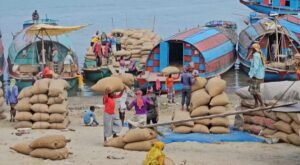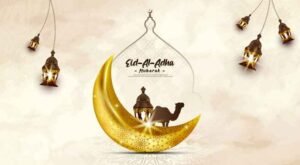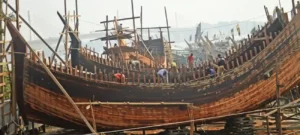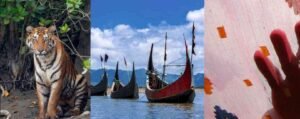Ashuganj’s Century-Old Rice Market Home / BOC Ghat sits about...
9 Wonders of Sitakunda That Will Surprise You
Discover the 9 amazing wonders of Sitakunda that will leave you in awe. From breathtaking landscapes to rich cultural heritage, explore what makes this hidden gem in Bangladesh truly special.
Green hills standing tall against the blue sky — that’s the Sitakunda of Chittagong, the hill-covered gem of Chittagong. Though small in size, with just 148 square kilometers of land, it’s home to over a million people.
To the south lies Pahartali, Mirsarai is to the north, vast hills stretch out to the east, and the Sandwip Channel flows along the west.
Sitakunda has become even more popular lately, especially for day trips from places like Dhaka, Chittagong, Feni, and Cumilla.
Some visitors come to camp, while others go trekking through the hills and cool off under waterfalls — all in a single day before heading home. In this episode of Bangladesh Wonders, we’ll explore 9 amazing features that make Sitakunda truly special.
The Origin of the Name
— — — — — — — — — —— — — — — — —
There are many legends behind the naming of Sitakunda. One popular story says that Lord Ramchandra, following his father’s command, went into exile with his wife Sita and brother Lakshman.
They stayed here for a few days during their journey. Sita used to bathe in the hill streams or ponds — called “kunds” — in this area. Over time, the place came to be known as Sitakunda, named after her.
Beside the local Bhairab Temple stands a timeless banyan tree known as Batubriksha. According to legend, Sage Vyasa sat under this very tree and composed the Vana Parva — the Forest Book — of the epic Mahabharata.
1. Chandranath Hill
— — — — — — — — — —— — — ——
Chandranath Hill is the tallest peak in the Sitakunda hill range, standing at 1,155 feet. At its summit sits the sacred Chandranath Temple. Every day, thousands of devotees visit this temple from across Bangladesh and even remote parts of the Indian subcontinent.
During the Shiv Chaturdashi festival, millions of Hindu pilgrims from all over the subcontinent gather here to celebrate and seek blessings.
2. Hills and Forests
— — — — — — — —— — — ————
Lush green forests surround the Sitakunda hill range. The area includes nearly 25,000 acres of government-protected forest. After climbing the steep paths, you’ll witness a breathtaking stretch of hills reaching to the horizon.
These hills date back to the Pliocene epoch of the Tertiary period — they are about 5 million years old.
3. The Tripura Community in Sitakunda
— — — — — — — — — — — — — — — — — — — — — — — — — — ———
Outside the greater Chittagong Hill Tracts, Tripura communities also live in Comilla and Sylhet. In Sitakunda, nearly 12,000 Tripura people reside. While others call them “Tripura,” they refer to themselves as “Tuipra.” In their language, “Tui” means river, and “Pra” means dwellers—so “Tuipra” means river dwellers.
This community migrated from Tripura in the 15th century and first settled along the Bay of Bengal. Storms, floods, and natural disasters were a constant threat. To escape, they moved toward the forest-covered hills.
Traveling through Sitakunda and Hinguli, they spread into areas like Ramgarh, Matiranga, Gomti, Panchhari, Khagrachari, and Dighinala. Some chose to stay in Sitakunda, and their descendants still live here today.
Jhum farming is their main occupation, but their view of wealth is quite different. To the Tripura people, houses are not considered wealth. Instead, animals, birds, gold, ornaments, money, utensils, and clothing are what define wealth.
Though their families follow a patriarchal system, inheritance is shared: sons receive the father’s property, and daughters inherit from the mother. The parents are responsible for managing the family’s wealth.
4. Jhum Crops
— — — — — —— — — ——
On the tough, hilly soil, the Tripura people practice jhum farming, growing various vegetables, including beans. Their language is called Kokborok, where “Kok” means language and “Borok” means people—so Kokborok means the language of the people.
A long stream called Karkar River, flowing down from the Kumari Kunda hills, supports their daily life and farming. According to mythology, this stream got its name from ancient tales.
The Tripura community depends on this water for both living and agriculture. Alongside the flowing stream, a nearly flat walking path has naturally formed, allowing people to travel easily through the hills.
5. Ship Breaking Yard
— — — — — — —— — — — — — — ——
The ships that lose their ability to sail and become old at sea are bought from Singapore and Hong Kong and dismantled in these yards. Each ship is as tall as a 5 to 10-story building. The height of each propeller blade is almost equal to the height of two people.
The metal extracted from these ships is used in the country’s construction industry. The wood, furniture, and various home appliances salvaged from the ships partially meet the domestic demand.
These shipbreaking yards provide employment for thousands of workers. The workers, while doing the tough work, often sing their group songs to ease the labor.
6. Eco Park
— — — — — — ———
To protect the forest, more than 5,000 trees of various species, both local and foreign, have been planted. The Sitakunda Eco Park has been created.
The park features gardens with rare species of trees, animal food plants, numerous flower gardens, an artificial lake, and protected areas for rare species of animals and birds.
Hidden within the park’s mountainous landscape is a mysterious nature. This naturally formed park also has two waterfalls.
Flowing from the deep places of high mountains, the “Supta Dhara” waterfall creates a continuous rhythm as it cascades down. The “Sahasra Dhara” waterfall flows along the rocky mountain surface, illuminated by the sun’s light, creating a stunning sight.
7. Kumira Ghat
— — — — — — ——— — ——
A canal runs alongside Kumira Ghat in Sitakunda, merging with the sea. On the shore, gang pigeons wait, eager to catch fish. Fishermen, with baskets full of fish, return from the sea, breaking through the muddy water.
On the opposite side of Kumira, there is a dense island. People come from Sandwip and disembark at Kumira Ghat. One group leaves, and another arrives.
8. Rajkhali
— — — — — — ——-
A speedboat rushes ahead at full speed. People from Sandwip also travel through Rajkhali Ghat. Located along the coast, Rajkhali is surrounded by coastal greenery.
Across all of Sitakunda, the total area of coastal forests is 2,698 acres. Along the shore, the green forests and trees meet with resting ducks and birds, creating a peaceful natural scene.
Like in other regions of Bangladesh, Sitakunda has its traditional village with clean courtyards, mud houses, and an array of flowering plants along the edges.
9. Ancient Maritime Port & Sitakunda history
— — — — — — — — — — — — — —— — — — — — — — —— — — — — — — — —
The name Sitakunda is closely linked with ancient maritime trade. According to the historic book periplus of the erythraean sea, the southern part of Sitakunda was home to the ancient Chittagong port, known as Bandar Ganga City.
Though the port no longer exists in Sitakunda today, it has become a shipbreaking yard. Currently, there are over 100 shipbreaking yards operating here.
Now a Days Sitakunda of Chittagong is going on of the best tourist destination for both nature lovers and Hindus religious believers. You can make your next plan to visit into Sitakunda.
The Culture of Eid al-Adha in Bangladesh
The Culture of Eid al-Adha in Bangladesh Eid al-Adha is...
Fishing Trawler Made in Bangladesh
Home / Fishing Trawler Made in Bangladesh About 10 kilometers...
Top 7 Wonders of Bangladesh | 7 Wonders of the World
Home / Top 7 Wonders of Bangladesh Do you know...



